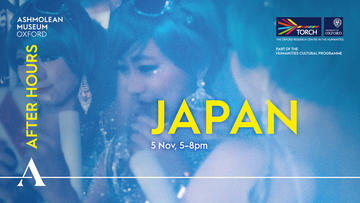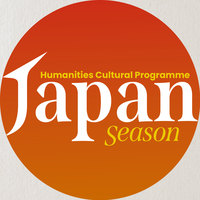After Hours: Japan

JAPAN SEASON 2021
Part of the Humanities Cultural Programme, one of the founding stones for the
future Stephen A. Schwarzman Centre for the Humanities.
After Hours: Japan
Friday 5th November 2021, 5.00pm -8.00pm at the Ashmolean Museum.
An exciting ‘after hours’ programme of activities at the Ashmolean Museum showcasing the diverse range of researchers and performers who are connected to Japan. Come and try your hand at woodcut printing, or why not learn some Japanese? Listen to the performers in the central atrium and connect with new and interesting aspects of Japan.
Japan encompasses many different contributions to the world - and this is reflected in the diverse ways in which it is studied and researched at Oxford. The arts and culture, alongside the rich histories, literatures and languages of Japan, will feature as part of a wide-reaching cultural festival in late 2021, led by the University of Oxford as part of the Humanities Cultural Programme.
Bringing together artists and performers based both in the UK and in Japan, the events series will engage the wider public through public events, grounded in collaboration. This festival will both showcase the work of creative performers and artists and reach diverse large audiences in Oxford; it will also have a global reach where the material goes online. We will connect with key organisations and artists as we bring together and celebrate the arts and culture of Japan.
HIGHLIGHTS REEL
https://www.youtube.com/embed/qZqu2yp-y50
PROGRAMME
PERFORMANCES
ATRIUM
6.00-6.30pm
Koto & Shakuhachi duet (Koto & Flute)
Performed by Justin Senryū Williams & Keiko Kitamura
Justin Senryū Williams plays ensemble music in the tradition of Kinko Ryū Araki Ha, the oldest guild of shakuhachi. He also specialises in teaching the 6 ancient regional styles of honkyoku, the solo repertoire of the shakuhachi from the Fuke school of Japanese Buddhism.
Website: http://senryushakuhachi.com/
Keiko Kitamura has worked extensively with a variety of traditional Japanese and contemporary Western musicians. She was an award winner for her koto composition at the Miyagi Michio Memorial Contest 2014. She is a member of SO-DO Academy of Music which is led by Tomoko Sunazaki. Website: http://keikokitamura.com/
7.00-7.30pm
Dance Artefact 4: Tokyo remix
Performed by Marie-Gabrielle Rotie with music by Nick Parkin
An improvised performance by Marie-Gabrielle Rotie, with live and recorded sound by Nick Parkin. An embodied and fragmented collage of images transposed into the body and expressed physically through the lens of Butoh Dance.
Marie-Gabrielle Rotie. For the past 30 years, Marie-Gabrielle has worked as a performer, dancer, and choreographer for theatre and opera, including the Royal Shakespeare Company and the Royal National Theatre. She has toured nationally and internationally and has had a long career as a soloist, funded and commissioned by Arts Council, Trinity Laban and The Place Theatre. Marie-Gabrielle has studied Butoh in Japan and Europe since 1993 and was choreographer for the film Directed by Robert Eggers ‘The Northman’ due for release April 2022. She also hold a permanent post at Goldsmiths University of London teaching in Theatre and Performance.
Website: www.rotie.co.uk and www.butohuk.com
Nick Parkin is an Award Winning Composer, Multi-Instrumentalist and Sound Designer. He holds an MA in Electroacoustic Music Composition from the University of East Anglia, and has worked with various bands and dance and theatre companies in the UK and Europe since the 1980’s. His music has been used by the BBC, Radio 4, Radio 3, Channel 4 in the UK, and broadcast internationally, ranging from Atmospheric Electronic & Electro- Acoustic Soundscapes to Instrumental Contemporary Classical compositions. His albums can be found on iTunes, Spotify and other digital outlets worldwide.
PROJECTIONS
ATRIUM WINDOW
Marewrew’s Voice
Excerpts from a film created by Eiko Soga, Artist and Researcher, Ruskin School of Art and St. John’s College, University of Oxford. Marewrew’s Voice introduces Ainu music and a group of artists called Marewrew (meaning ‘butterfly’ in the Ainu language) who engage with the traditional style of Ainu songs called ‘Upopo’. The full film ‘Marewrew’s Voice’ is available to watch on the TORCH Oxford YouTube channel.
The Legend of Urashima Taro
One of the most well-known folk-tales of Japan, Urashima Taro is a story whose ending defies expectation, and whose ultimate moral is ambiguous. What is the relationship between goodness and reward; between humans and the rest of nature? What is the meaning of human mortality in the face of earth’s endless renewal and change? What does it mean to have hope? And what are the consequences of losing it? In this simple and beautiful retelling, these questions are left for the viewer to ponder, as they have been for generations.
Text adapted from Mythological Japan: The Symbolisms of Mythology in Relation to Japanese Art (1902). Puppets and Concept: Anthony Hosein and Stacey Loewen. Puppeteers: Stacey Loewen and Anthony Hosein. Music: Stacey Loewen. Website: www.harponthehill.com
TALKS
HEDLEY LECTURE THEATRE
5.15pm: JAPAN IN HOLLYWOOD
From the 1940s to the mid-1960s Hollywood made dozens of films either set in or filmed on location in Japan – featuring stars like Humphrey Bogart, Marlon Brando, Glenn Ford and Rosalind Russell – and nearly all now unremembered. Philip Grover introduces these films and looks at the main themes which emerge, drawing also on film stills and original lobby cards from his personal collection. Please note that these images will also be available to view in gallery 31.
Philip Grover, Assistant Curator, Pitt Rivers Museum, Oxford
5.45pm: IF ROBOTS STEAL OUR JOBS, WILL THEY ALSO TAKE OUT OUR TRASH?
How British and Japanese experts predict technological transformations in the domestic sphere.
Dr Ekaterina Hertog, and Lulu Shi (Sociology of Japanese Society, Department of Sociology). Based on a paper co-authored by: Vili Lehdonvirta1, Lulu P. Shi1, Ekaterina Hertog1, Nobuko Nagase2, Yuji Ohta2 (1 Oxford University, 2 Ochanomizu. University)
6.15pm: JAPAN’S SHRINKING AND AGING POPULATION
The Japanese population is both aging and shrinking faster than any population has ever aged or shrunk outside war or plague. The population is already getting smaller by over 500,000 people a year (= Sheffield) and this will soon rise to 1 million a year (= Amsterdam). If people are living longer, why is the population shrinking? And what does it mean Japan will look like in 2065?
Professor Roger Goodman, Nissan Professor of Modern Japanese Studies
6.45pm: ‘3.11’ TEN YEARS ON: REFLECTIONS FROM TŌHOKU
Over ten years have elapsed since ‘3.11’, the Great Eastern Japan Earthquake, tsunami and nuclear meltdowns at Fukushima, and memories of the catastrophe still constitute part of the fabric of daily life in the former disaster areas. This talk considers how the disaster inspired a rethinking of regional identity in the Tōhoku region, with particular attention to post 3.11 literature.
Dr Linda Flores, Associate Professor in Japanese, Oriental Institute, Fellow in Japanese and Welfare & Equality Fellow, Pembroke College University of Oxford
ACTIVITIES
DISPLAY: Japan in Hollywood (Gallery 31)
From the 1940s to the mid-1960s Hollywood made dozens of films either set in or filmed on location in Japan – featuring stars like Humphrey Bogart, Marlon Brando, Glenn Ford and Rosalind Russell – and nearly all now unremembered. Philip Grover introduces these films and looks at the main themes which emerge, drawing also on film stills and original lobby cards from his personal collection. Please note that a talk will also take place in the Lecture Theatre during the evening.
Philip Grover, Assistant Curator, Pitt Rivers Museum, Oxford
QUIZ (Gallery 23)
Will smart technology be up for doing our housework and care work soon?
Have a guess and compare with Japanese experts' predictions. This quiz will be available via QR code to complete in your own time during the evening.
Dr Ekaterina Hertog, Sociology of Japanese Society, Department of Sociology
TOKYO EXHIBITION DISPLAY (Eastern Art Study Room)
View additional works from the Tokyo: Art & Photography exhibition with curator, Clare Pollard. (max 8 people at a time)
Clare Pollard, Curator of Japanese Art, Ashmolean Museum
DIGITAL DISPLAY (Welcome area display screens)
Photo shoot curated by TORCH intern Nicole Lindsay.
WOODBLOCK PRINTING WORKSHOP (Education Centre)
Nature, Culture, Colour & Line: Explore Japanese woodblock techniques used in the making of iconic woodblock images. Participants will be able to ink and hand print hand carved and digitally engraved images relating to historical and contemporary works in the exhibition and newly created interpretations.
Timings: 5pm, 5.35pm, 6pm, 6.35pm, 7pm. Please note this is limited to 10 people per session on a first come first served basis.
Graeme Lee Hughes, Artist & Printmaker, Printmaking Tutor at The Ruskin School of Art, Oxford University.
WASEI EIGO (Gallery 6)
Match up ‘wasei eigo’ words (common English words invented in Japan) using flashcards.
Hannah Kentridge (MPhil in Japanese Studies, Sasakawa Foundation Scholar - and YouTube content creator) & Tom Sutton (MPhil in Japanese studies and a Daiwa Scholar)
THE INTERNATIONAL ORIGINS OF FAMOUS JAPANESE DISHES (Gallery 6)
Identify Japanese food items on a world map and find out how different dishes travelled between countries and changed to become the dishes we think of as ‘Japanese’ in the UK today.
Hannah Kentridge (MPhil in Japanese Studies, Sasakawa Foundation Scholar - and YouTube content creator) & Tom Sutton (MPhil in Japanese studies and a Daiwa Scholar)
WHAT DOES J-POP DANCING MEAN? (Gallery 44)
A brief presentation on 'communicating through J-Pop dance’ with a 15 minute dance workshop with oKay dance group. Timings: 5.30pm, 6.00pm, 6.30pm, 7.00pm. Limited to 12 people per session, on a first come first served basis.
Dr Laurence Mann (Senior Lecturer in Japanese Language, Oxford Brookes University, Associate Faculty Member, Faculty of Oriental Studies, University of Oxford)
EXPERIENCE JAPANESE PRAYER (Gallery 33)
A Japanese prayer experience containing a selection of norito (Shinto prayers) alongside an explanation of what the prayers signify and how they are communicated.
Dr Laurence Mann (Senior Lecturer in Japanese Language, Oxford Brookes University, Associate Faculty Member, Faculty of Oriental Studies, University of Oxford)
SHADOW PUPPETS DISPLAY (Gallery 21)
Display from East Oxford Primary School, following a recent shadow puppet-making workshop.

Find out more about the Japan 2021 – Humanities Cultural Programme here.


